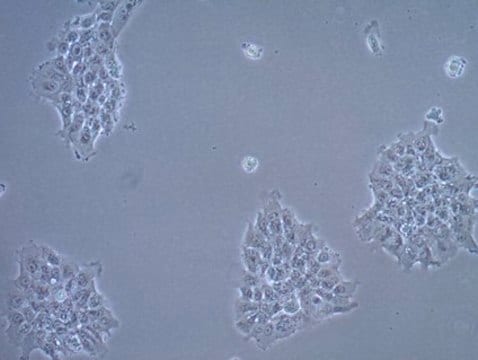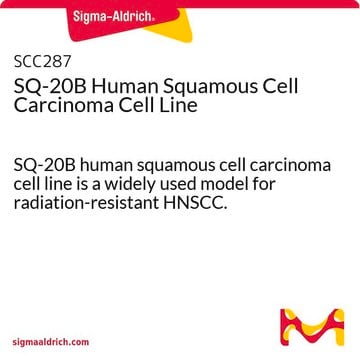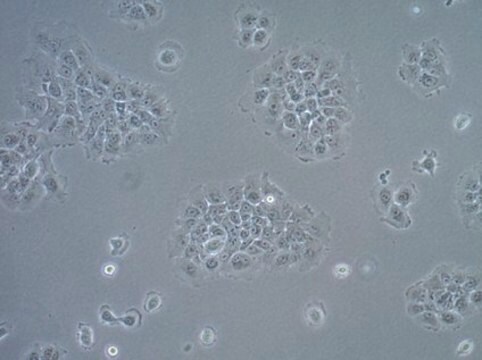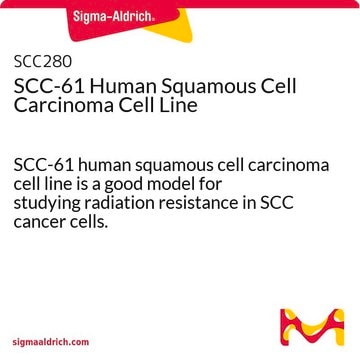SCC071
UM-SCC-47 HPV-16 Positive Squamous Carcinoma Cell Line
Human
Synonym(e):
University Michigan Squamous Cell Carcinoma, UMSCC47, H&N squamous cell carcinoma cell line, Head and neck squamous cell carcinoma cell line, HNSCC
About This Item
Empfohlene Produkte
product name
UM-SCC-47 HPV-16 Positive Squamous Carcinoma Cell Line, suitable in vitro model of H&N carcinoma studies
Biologische Quelle
human
Qualitätsniveau
Methode(n)
cell culture | mammalian: suitable
Versandbedingung
liquid nitrogen
Allgemeine Beschreibung
THIS PRODUCT IS ONLY AVAILABLE FOR SALE TO ACADEMIC INSTITUTIONS OR NOT-FOR-PROFIT ENTITIES FOR USE UNDER THIS LIMITED USE LABEL LICENSE. FOR INFORMATION ON COMMERCIAL LICENSING OF UM-SCC CELLS, INCLUDING LICENSING TO COMMERCIAL ENTITIES, PLEASE CONTACT: licensing@emdmillipore.com
Head and neck squamous-cell carcinoma (HNSCC) is the 6th most common type of cancer world-wide. The cancer may occur in the lip, oral cavity, nasal cavity, paranasal sinuses, salivary glands, pharynx and larynx. Risk factors include smoking, alcohol consumption, betel nut chewing, wood dust exposures and human papilloma virus (HPV) infections. Approximately 15% of HNSCC contain genomic DNA from HPV. In particular, HPV-16 occurs in 90-95% of all HPV-positive HNSCC cases. In oral and pharynx cancer, HPV DNA is found in the tonsils in 45-67% of the cases. HPV DNA is found in 13-25% of the cases in the hypopharynx, 12-18% in the oral cavity and 3-7% in the larynx.
UM-SCC-47 is a unique head and neck squamous carcinoma cell line isolated from the primary tumor of the lateral tongue of a male patient. The cell line contains 18 copies of integrated HPV-16.
UM-SCC-47 was established at the University of Michigan with written informed consent obtained from the patient and with the approval of the study by the Medical School Institutional Review Board.
Reference:
1) Carey, T., et al. (2012) Genotyping of 73 UM-SCC head and neck squamous cell carcinoma cell lines. Head Neck. 2010 April; 32(4): 417–426.
Beschreibung der Zelllinie
Anwendung
Infektionskrankheiten
Entzündung & Immunologie
Apoptose & Krebs
Komponenten
Qualität
• Cells are tested by PCR and are positive for HPV-16 and negative for Hepatitis A, B, C and HIV-1 & 2 viruses.
• Cells are negative for mycoplasma contamination.
• Each lot of cells are genotyped by STR analysis to verify the unique identity of the cell line.
Lagerung und Haltbarkeit
Haftungsausschluss
Lagerklassenschlüssel
6.2 - Infectious substances
WGK
WGK 1
Flammpunkt (°F)
Not applicable
Flammpunkt (°C)
Not applicable
Analysenzertifikate (COA)
Suchen Sie nach Analysenzertifikate (COA), indem Sie die Lot-/Chargennummer des Produkts eingeben. Lot- und Chargennummern sind auf dem Produktetikett hinter den Wörtern ‘Lot’ oder ‘Batch’ (Lot oder Charge) zu finden.
Besitzen Sie dieses Produkt bereits?
In der Dokumentenbibliothek finden Sie die Dokumentation zu den Produkten, die Sie kürzlich erworben haben.
Artikel
AldeRed™ 588-A detects ALDH activity in cancer stem cells, aiding in cancer research.
Unser Team von Wissenschaftlern verfügt über Erfahrung in allen Forschungsbereichen einschließlich Life Science, Materialwissenschaften, chemischer Synthese, Chromatographie, Analytik und vielen mehr..
Setzen Sie sich mit dem technischen Dienst in Verbindung.








